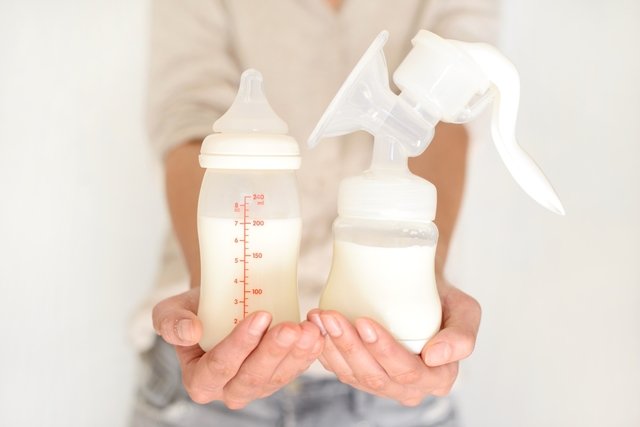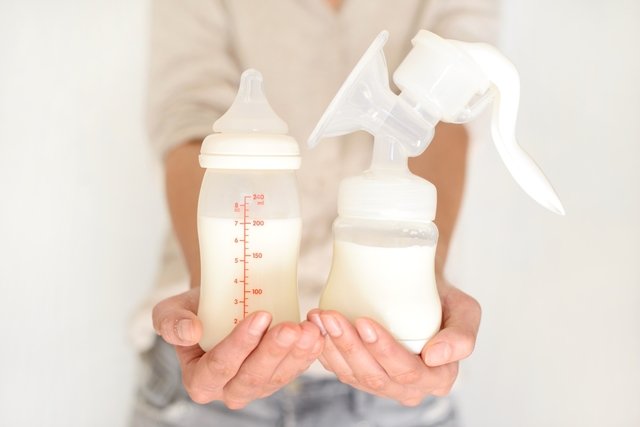Breast milk is the best food that can be given to the baby. However, there are situations in which it is not possible to breastfeed or in which it is preferable to give milk in a bottle and, to do so, it is necessary to express milk from the breast.
There are several ways to express breast milk, which can be done with your hands or with a manual or electric pump, depending on how often you want to express the milk and each woman’s preference. For any method, you should always maintain good hygiene and follow tips that ensure the quality of the milk for the baby and the best comfort for the mother.
Know the composition of breast milk and understand its importance for the baby.

What to do before expressing milk
Before expressing breast milk, manually or with a pump, there are some very important precautions such as:
- Wash your hands well with soap and water;
- Wash and sterilize, or boil, the necessary materials, including the containers where the milk will be stored;
- Massage the breast with light, circular movements, towards the nipple, using your fingertips.
It is also important that the mother tries to relax by choosing a quiet place to express the milk. Other good tips include looking at the baby, listening to music or taking a bath beforehand, for example.
How to express milk manually
Although it may be more difficult than using a pump, breast milk can also be expressed by hand. To do this, you must place your thumb about 2 to 3 centimeters above the nipple and your index and middle fingers about 2 to 3 cm slightly below, making the shape of a “C” with your hands. Then, you should press the breast lightly against the ribs and apply pressure with your index finger and thumb. Finally, just release the pressure and repeat again, making rhythmic movements.
It may be difficult at first, but then the woman can usually find a rhythm, which will help to express the milk more easily. Normally the process takes between 20 and 30 minutes and the milk must be collected in a boiled or sterilized container with a wide opening.
Choosing the best pump to express milk is related to how often the mother plans to feed the baby through a bottle. Thus, if the mother intends to give her milk with a bottle only once or twice a week, it is enough to use a manual pump, however, if she intends to express milk more often, the best option may be to use an electric pump, in which the milk is extracted more quickly and effortlessly.
1. Manual pump
There are several manual pumps on the market, the method of use of which may vary slightly. However, what you need to do in most of them is:
- Place the pump funnel over the breast so that the nipple is properly centered;
- Hold the breast shield against the breast with the help of the thumb and index finger, supporting the breast with the palm of the hand;
- Start the extraction process according to pump instructions.
Since there are several different models, it is always advisable to consult the manufacturer’s instructions. If you want to express milk from both breasts, you should alternate between breasts every 2 or 3 minutes, as this allows you to extract a greater amount of milk.
2. Electric pump
Electric pumps are easier to use and can be single, if they extract milk from one breast at a time, or double, if the extraction occurs in both breasts at the same time. There are several different electric pumps for sale, which may have several modes available, such as speed or pressure adjustment, for example.
To correctly use the electric pump, you must:
- Adjust the pump funnel to the nipple, leaving space between the funnel wall and the nipple;
- Choose the suction force, which should be maximum comfortable. To do this, you can increase the suction force slowly;
- Massage the breast during expression, making circular movements around the areola, to stimulate the flow of milk.
Expressing milk should never be painful and if the woman feels pain, she should stop the process immediately.
How to wash the pump
Breast pumps must always be washed before and after each use, according to the manufacturer’s instructions.
Generally, a deeper wash should be done per day, and to do this, the extraction kit should be disassembled into individual parts and the non-electrical components should be boiled for approximately 5 minutes in water. Electrical components must be cleaned with a dry cloth.
In any case, before cleaning, you should always read the manufacturer’s instructions first, to avoid any damage to the pump.
When is it recommended to express breast milk
Breast milk is the best food that can be given to a baby, especially during the first 6 months of life. However, there are situations in which the baby cannot express milk directly from the breast. This happens more frequently in very small or premature babies, who cannot suckle effectively.
In addition, expressing milk can also be a good way to ensure breastfeeding when the mother needs to be away, when she is sick or when she needs to take medication during the breastfeeding period. In some cases, expressing breast milk can also be done to help the baby latch on to the breast when it is too full, to stimulate milk production or when the mother wishes to donate milk, for example. Understand how breast milk donation works and how to donate.
It is important to remember that the more the breast is emptied, the more milk is produced. Therefore, it is recommended to establish a withdrawal routine so that production can be carried out more efficiently. Ideally, milk should be expressed from the breast between 8 and 10 times a day.
How to store breast milk
The storage time for breast milk varies depending on the temperature at which it is placed:
- Room temperature: 6 to 8 hours;
- Refrigerator (0 to 4ºC): up to 8 days;
- Refrigerator (4 to 10ºC): up to 3 days;
- Freezer refrigerator: up to 6 months;
- Freezer horizontal: more than 6 months.
Milk must be stored in suitable containers, which can be purchased at the pharmacy, or in glass containers. Learn more about how to properly store breast milk.

Sign up for our newsletter and stay up to date with exclusive news
that can transform your routine!
Warning: Undefined array key "title" in /home/storelat/public_html/wp-content/plugins/link-whisper-premium/templates/frontend/related-posts.php on line 12
Warning: Undefined array key "title_tag" in /home/storelat/public_html/wp-content/plugins/link-whisper-premium/templates/frontend/related-posts.php on line 13




